Our New Breed of Readers: Laptops, iPads, and e-Books
The line between fiction and nonfiction is blurring and the definition of a book has changed. The knowledge, skills, attitudes, and dispositions needed to succeed are evolving. In addition to discussing e-books and iPad resources, the session will explore how our new breed of reader learns in a transmedia world and what librarians can do to support both fiction and nonfiction reading needs. What does it mean to be a reader?
Use iPad Peek to see what a webpage will look like on an iPad.
History and Trends in Digital Reading
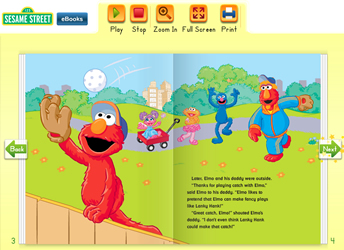 The past twenty years have seen many trends in computer-based reading experiences. Introduced in 1992, Living Books on CD-ROM were a great example of reading experiences with audio and interactive support. Unfortunately, these electronic reading environments never really took hold beyond books for beginning readers and a few reference resources from DK. The DK materials provided informational reading experiences and worked well for classroom reading activities.
The past twenty years have seen many trends in computer-based reading experiences. Introduced in 1992, Living Books on CD-ROM were a great example of reading experiences with audio and interactive support. Unfortunately, these electronic reading environments never really took hold beyond books for beginning readers and a few reference resources from DK. The DK materials provided informational reading experiences and worked well for classroom reading activities.
By the late 1990s and early 2000s, people expected free materials from the web. However, free websites like Enchanted Learning with quality content were difficult to find, poorly formatted and contained annoying ads. Students could read classics online at websites such as the Project Gutenberg, however only a few free resources emerged such as International Children's Digital Library with books like Blue Sky.
Throughout the 2000s, some websites such as Sesame Street ebook website rotated a few free online books each week such as Elmo 'N Daddy. However most ad-free websites have become subscription-based such asTumblebooks.
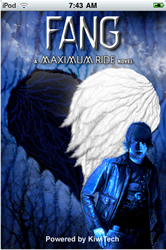 The introduction of mobile Apps such as Freight Train has renewed interest in interactive storybooks. These types of extended reading experiences are now reaching beyond the elementary grades. New companies are specializing in these types of interactive storybooks. For instance, the TouchyBooks app contains a number of child-friendly demo stories.
The introduction of mobile Apps such as Freight Train has renewed interest in interactive storybooks. These types of extended reading experiences are now reaching beyond the elementary grades. New companies are specializing in these types of interactive storybooks. For instance, the TouchyBooks app contains a number of child-friendly demo stories.
James Patterson's Maximum Ride series are all available as Kindle eBooks that can be read on many types of devices including iPhone, Windows PC, Mac, Blackberry, iPad, Android, and Windows Phone 7 in addition to the Kindle Reader. In addition, supplemental materials are also available in various formats through the author's website. There's a FANG mobile App connected to Book One.
Some apps are designed for use on websites. For instance, readers of theVampire Academy series can learn more about the series on a Facebook App while reading the electronic book on the ipad and connecting to social networks.
E.O. Wilson's Life on Earth e-book is the first truly interactive, multimedia textbook.
It's taken 20 years for the idea of age-appropriate, interactive books to make a come-back. However, with this return has come an explosion of reading choices and a new definition of "book."
 Try It!
Try It!
What do you see as the most important trends related to digital reading?
How are you planning for next year and beyond?
Redefining "Reading a Book"
Read The Pedlar Lady of Gushing Cross from Moving Tales. Watch the movie trailer for The Pedlar Lady of Gusting Cross on YouTube. Is this a book? Why or why not? What makes a book a book?
It's time to redefine what we mean by "reading a book".
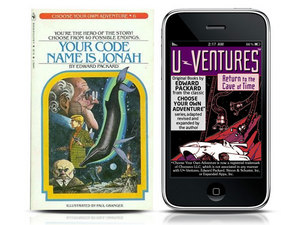 What's involved with the activity of reading? Does it need to be text or can it include graphics, sounds, motion, and other kinds of symbols? Does reading need to have a traditional start and finish or could it be created as the reader moves through the experience? Consider a revised definition that encompassed all these elements.
What's involved with the activity of reading? Does it need to be text or can it include graphics, sounds, motion, and other kinds of symbols? Does reading need to have a traditional start and finish or could it be created as the reader moves through the experience? Consider a revised definition that encompassed all these elements.
Reading is the process of constructing meaning from symbols.
What's required for something to be a book? Does it need to be paper or can it be digital? Can it contain artifacts or other elements? Does it need to have pages? Does it need to be linear or can it be branched or chaotic?
A book is a published collection of connected pages or screens.
Does the phrase "reading a book" need to be redefined? If so, how?
 Try It!
Try It!
Discuss whether you think the definition of "reading a book" is changing and why. What's your definition?
Five Electronic Reading Environments
What do the words reading and books mean in a transmedia universe? Will the traditional words evolve in meaning or do we need new words? Consider some of the following categories. Is this reading? Are these books?
1) e-books
E-books feature linear content equivalent to a print book. However many of the e-book devices contain tools such as highlighter, dictionaries, and notetaking options. Many popular authors are producing electronic book versions of their books. Enhanced e-books contain multimodal features within the linear text such as images, web links, and embedded media. Many nonfiction books are incorporating media elements.
Example: The Hunger Games series and others by Suzanne Collins are available for ebook readers.
Example: The Kennedy Detail contains images and embedded media and is available for ebook readers.
2) Interactive Storybooks
Interactive storybooks feature a linear story read-aloud by a narrator. Text is often highlighted as the words are read and options may be provided for defining words or exploring elements of the screen. Many of these storybooks have options to "read to me," "read myself," and "play with me" provided different ways to access the story. First available on CD-ROM, many of these books are now available as mobile Apps for phones and tablets.
Example: Watch a demo of One Snowy Day from YouTube. Download it at iTunes.
3) Reference Databases
 Reference Databases provide nonlinear, organized access to records of information provided through search tools, indexes, or subjects.
Reference Databases provide nonlinear, organized access to records of information provided through search tools, indexes, or subjects.
Example: The series include free and purchased versions. ibirds pro is the complete version. In Star Walk for the iPad you can associate the text with the actual place.
4) HyperTexts & Interactive Fiction
Hypertexts and interactive fiction are nonlinear narratives that can be accessed through various hotspots or links. Choose your own adventure stories are interactive fiction. Many adventure games also contain narratives. Read or listen to Choose Your Own Adventure Gets an iMakeover from NPR (August 16, 2010) to learn more about this format.
Example: 253 or Tube Theatre by Geoff Ryman is an example of a hypertext.
5) Transmedia Storytelling
Transmedia storytelling involves a multimodal, multmedia story with nonlinear, participatory elements. Resources connected to the story might including print materials, documents, maps, web-based clues, mobile Apps, cell phone calls, social media connections, activities and games, and media (audio, video, animation). The main line of the story may or may not be in one location such as a traditional book or website. The narrative may be told through a series of media. 39 Clues, Skeleton Creek, Cathy's Book are all examples.
Example: The Amanda Project: experience website, fictional school website
Schneider (2005, 198) states that "the readers of hypertexts thus appear as empowered readers, liberated from the constraints imposed by 'traditional' literature – some commentators even raise the question whether the very terms 'reader' and 'reading' might not have become inadequate for hypertext reception". This type of reading requires skills not required in traditional reading.
Books like 39 Clues, Skeleton Creek, and Harry Potter all connect books with online resources including games, videos, and interactive content.
 Try It!
Try It!
Do the examples above fit your definition of "reading a book"?
Fiction and Nonfiction
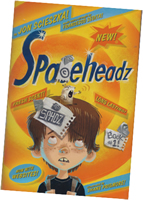 In this transmedia world, it's going to be more important than ever for young people to be able to evaluate information and distinguish fact from fiction. Scholastic Bookflix is a subscription service that pairs fiction and nonfiction reading to provide this foundation.
In this transmedia world, it's going to be more important than ever for young people to be able to evaluate information and distinguish fact from fiction. Scholastic Bookflix is a subscription service that pairs fiction and nonfiction reading to provide this foundation.
How do fiction and nonfiction differ?
Traditional fiction is a representation that is invented, imaginary, and not factual, while nonfiction is information that is real, truthful, and factual. What happens in augmented or alternative reality situations when you're in a fictional world working with informational materials? Or, you're in the real world working with fictional materials?
In the intermediate level fiction book titled Spaceheadz by Jon Scieszka, readers are taken to information websites. They look like nonfiction websites, but are they really fiction because they're invented for use with the book? Examples include SPHDZ, Anti-alien Agency, and Mrs. Halley's Comets class.
 Try It!
Try It!
Is transmedia storytelling changing how people think about fiction and nonfiction?
Five Features Enhance Reading Experiences
The world of reading is changing in some ways and not in others. Text is text. Readers easily shifted from hardcover to paperback to e-books. In addition, there are now more options to enhance the reading experience such as read-aloud, bookmarks, definitions, audio, video.
Let's explore five features that can enhance the reading experience:
1) Navigation: Clear vs Confusing
When reading a traditional book, navigation simply involves selecting and moving among pages. With electronic reading, additional navigation is needed to provide orientation and facilitate the reading experience.
Orientation. Whenever possible, interactive materials should be easy-to-use and intuitive. Rather than lengthy instructions, readers should be able to jump into the materials. For some readers, the use of forward and back arrows and page numbers are important to orientation. Replacing them with percent complete and other types of navigation are useful. However total elimination of navigation in favor of an exploration environment can be overwhelming for some students.
Some users may become lost in interactive texts. Schneider (2005) notes that this problem of coherence may be related to the uncertainty that comes from nonlinear texts. People are concerned that they might miss something or become distracted between screens. Notice the arrow options on books such as 1-2-3 The Ants Go Marching.
 Search Tools. Search tools help readers easily find passages. Reference materials are popular apps. For instance, Zoo Who? An Animal Encyclopediaprovides information including text, audio, and video related to 600 animals (see image on right). Users can access this information through an alphabetical list of animals.
Search Tools. Search tools help readers easily find passages. Reference materials are popular apps. For instance, Zoo Who? An Animal Encyclopediaprovides information including text, audio, and video related to 600 animals (see image on right). Users can access this information through an alphabetical list of animals.
Learner Control. Students may control the depth, pacing, and sequencing or their learning. Shamir and Korat (2006) identified five reading options learners might control including forward and backward buttons, interrupting, restarting, read text parts, and overview screen that students might control. In addition, dictionary access, print options, and illustration activation were other elements that could be controlled by the reader.
Reader control is an important advantage of interactive reading environments. According to Reinking and Schreiner (1985), this is particularly important with students who have special needs.Larson (2010) found that digital reading devices promote new literacy practices and provide readers control over how they engage the text.
However, Trushell, Burrell, and Maitland (2001) found that despite the availability of the arrows to move linear through the books, many children chose to go backwards or in a nonlinear way adversely affecting story recall. Underwood (2000) found that students had difficulty retelling the storyline when they used these nonlinear options.
Independence. A two-year old can operate an iPad independently. Many researchers (Pearman, 2008; Larson, 2010) have noted that struggling readers benefit by the support provided by interactive books with quality navigation.
2) Audio: Integral vs Incidental
Many books provide three or more options such as read the book aloud, read the book individual, play with the book. These may be available in separate sections or overlap. McKenna, Cowart, and Watkins (1997) found that the use of talking electronic books with struggling first grade readers significantly increased sight word recognition and reading levels.
Automatic or Selected Reading. Reading aloud to children is an important part of literacy development. However the entire class doesn't always need to experience the same book. Books with automatic read features provide this experience without intervention by the teacher.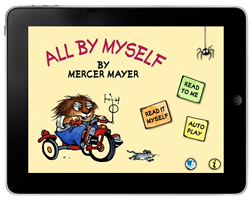
Options for audio may include individual words, phrases, paragraphs, or pages. In some cases the reader controls all of these elements. In others, control may be limited to individual words or whole paragraphs. Readers are able to hear and see the word in context. Reinking (1997) found that these audio aids remove the burden of decoding and free cognitive energy to focus on story comprehension.
Little Critter is one of the many characters being shared by Oceanhouse media.
Over-reliance on Audio. Some students choose to use the audio support rather than develop their own decoding skills. Lefever-Davis and Pearman (2005) found that young readers may repeatedly use the pronunciation features and never acquire the ability to decode new words.
Audio Speed. Bergman (1999) found that learner control of narration rate helps students acquire reading skills. Lerner Interactive Books are subscription-based and provide audio, single-world repeat, highlighted text, glossary, and whiteboard tools. The also provide learners with control over the speed of narration.
Sound Elements. In addition to spoken word elements, narratives can also have other sound elements. Music, sounds, and other audio effects can "aid comprehension by signaling the mood of the story and by cueing readers when an important event is going to occur" (Lefever-Davis and Pearman, 2005, p. 53). For instance, scary or happy music help children anticipate the mood of the story.
Incidental Audio. Unnecessary sound elements can distract from the experience. End users should be able to control these elements without losing the important auditory elements such as listening to dialog or hearing pronunciations.
Lefever-Davis and Pearman (2005) found that even transitional elements such as sounds related to page-turning and transitional animations can be annoying for some students. In addition, interactive hotspots that encourage prolonged game playing can be a particular problem for poor readers (Lewis and Ashton, 1999).
Giant Atom is another publishing group introducing ebooks such as Icarus Swinebuckle by Michael Garland. These books will read aloud pages or individual words. There is also an option to record your voice.
3) Graphics and Motion: Integral or Incidental
Like audio support, graphic and animation elements can support the storyline. For instance, a visual might clarify a word's meaning or provide a deeper understanding of a character.
Visual Design. Multiple panel may convey movement and a sequence of actions. Detailed graphics may extend understanding of character, plot, and setting. Colors may convey emotions. Images in borders or hidden in larger panels may convey clues. Multiple perspectives may be conveyed through chunks of information within the page.
From classics to popular fiction, you'll find lots of graphic novels adapted for the mobile format. For instance Stephenie Meyer's Twilight is now a graphic novel. Some traditionally text-based books are being enhanced with graphics. For instance, an illustrated version of The War of the Worlds by H.G. Wells is available for the iPad.
Visual Elements. Graphics play an integral part in comic stories. Classic Comics is producing Interactive Motion Comics (CD-ROM) that contain text, audio, and animation. Explore MacBeth as an example.
Incidental Graphics. Graphics and motion can distract from the experience. Trushell, Burrell, and Maitland (2001) found that the more intensive choice of "eye-candy" elements corresponded with poorer comprehension. For instance, if frogs jumping, grass swaying, and birds flying aren't integral to the story, they may be a distraction. When students are involved in lengthy exploration of elements not relating to the storyline, it's likely that they will loss focus on the important features.
4) Interactives: Integral vs Incidental
While some e-books provide a linear format, others allow for free reading and exploration. Shamir and Korat (2006) suggest selecting interactive storybooks that separate the reading aspects from the gaming elements. These elements may be used as springboard activities prior to the reading experience or as review following the story.
Spot Goes to School App separates exploration into reading and playing sections.
Activities that contribute to the story should reinforce key story elements. Games that involve retelling the story, exploring characters, or revisiting exciting story elements can contribute to reading comprehension and encourage a sense of discovery. Labbo and Kuhn (2000, p. 59) found that when audio, graphic, and activity elements are "integral to and supportive of the story" they contributed to student reading comprehension. Shamir and Korat (2006) also found that "activations" are effective as long as they are congruent with the story.
Lamont (1997) is concerned that interactive elements that repeatedly breaking off attention may reduce linear progression and negatively impact comprehension. The "bells and whistles" provided by some interactive books can distract participants and adversely impact comprehension. Trushell and Maitland (2005) found that access to "cued animations and sound effects" had adverse effects on student story recall.
The visual elements known as "eye-candy" can be a distraction. From interaction with hotspots to games, readers can easily lose focus on the story. Pearman and Chang (2010, p.54) stress that "the reader may never return to the story or, when they do, they may find the sequence of the story disrupted to the point where they can no longer follow the plot". Endless diversions can distract readers from the main line of the experience. While some readers may simply lose their way, others may have a difficult time identifying the important elements in the story line. These elements can hinder comprehension when they don't directly related to the story. Underwood (2000) reported that student recall of the story was poor when reading stories with interactive elements.Trushell and Maitland (2005) found that students who read interactive storybooks containing elements such as audio or animation that distracted from the written text scored poorly on story recall and inferential items when compared to those who read without those distractions. However they concluded that these adverse effects could be eliminated with teacher supervision. They also suggest that reading the text prior to "playing" with the text could contribute to comprehension.
Ruckus Media Group has introduced a series of e-books beginning including A Present for Milo by Mike Austin with 125 animations and more than 50 interactive elements. When focusing on reading comprehension skills it's important for teachers to guide use of interactive elements.
5) Tools: Seamless vs Distracting
While a traditional paper book only provides a physical way to locate information, e-books provide a variety of tools. For instance, virtual bookmarks provide an easy way to revisit a particular location in the book.
The DK Eyewitness Travel Guides provide background information on places around the world such as Paris. Users are provided with books for notetaking, sending messages, and other tools.
A growing number of books are connecting to movie components. For instance,Voyage of the Dawn Treaderis part of the C.S. Lewis series. The iBook contains illustrated interactive quiz questions, a color map, ship blue prints, and character information. Readers can view embedded video, using bookmarking tools, and set font sizes.
The How to Train Your Dragon interactive book and game is a great companion to the movie by the same name. FrogDog Media's iStoryTime series includes many interactive children's books based on popular animated movies. These books include movies, games, narration, and interaction.
Visual Display. In many cases readers have control over screen resolution, text color and background, font-size, and other display aspects. Larson (2010) found that young people used new literacy skills to personalize devices to meet their individual needs and preferences. For instance, some students prefer smaller text while others like larger font sizes.
Highlighted Text. While some beginning readers find it useful to have words highlighted as they read aloud, Trushell, Burrell, and Maitland (2001) found that slightly older children found it to be a distraction.
Dictionary Tools. The option to hear words pronounced aloud, read definitions, explore glossaries, see labels on illustrations, and experience other types of support is useful for readers of all ages. However it's particularly important for beginning readers. McNabb (1997) found that interactive elements lessen the decoding burden for readers when they encounter unknown words. They also provide opportunities for small group or individual reading with little teacher intervention. Larson (2010) found that young people used the support of a built-in dictionary and text-to-speech feature when it was available.
This support is particularly important for English as a Second Language students. Higgins and Hess (1998) found that students who used these supplemental features performed significantly better in defining vocabulary words.
Note-taking Tools. Many systems facilitate notetaking with tools such as highlighters and annotation tools. Users may be able to insert or remove text, markup pages, add comments, insert notes, attach files, or record audio. When using e-book readers with children, Larson (2010) identified five categories of response notes made by children: understanding of story, personal meaning making, questioning, answering, response to text features/literary evaluation.
Larson (2010) also noted the seamless nature of notetaking on an e-book reader. She noted that it provided new opportunities for individual engagement with the text.
Learn about many of the tools and options by watching the video iPad iMagineering from YouTube.
 Try It!
Try It!
What criteria will you use for selecting enhanced reading environments for students?
Five Real-World Issues
Technology in the classroom is changing how children learn and how we teach. While some children are reading books about castles, others are using the DK Eyewitness App to explore castles.
In her article Digital Literacies, Lotta Larson (2009, p.255) points out the today's readers are "immersed in multimodal experiences and, consequently, have a keen awareness of the possibility of combining modes and media to receive and communicate messages. This awareness results in an urgent need for teachers and researchers to address the discrepancy between the types of literacy experiences students encounter at school (paper, pencil, and print texts), and those they practice in their daily lives outside the school environment (Web 2.0). One way to bridge such incongruity is to expand the types of texts students are exposed to and engaged with at school by turning attention to electronic books, or e-books".
Let's explore five real-world issues.
1) The Devices
The classroom of the future will be filled with devices that serve different purposes. There isn't one answer. Instead, there are many to fit different needs.
- Kindles. A group of advanced readers are reading novels independently.
- iPads. A reading group reads independently while the teacher works with another group.
- iPod Touch. Students refer to a dictionary, vocabulary game, encyclopedia while working on a project.
- Laptop. Students conducting research create a Glogster, interactive poster.
- Desktop. A group sits together at one computer with a large monitor working on a video production.
 There are lots of ways to share Apps and e-books with the entire class.
There are lots of ways to share Apps and e-books with the entire class.
You can hook up your device to the data projector. There are many foreign language books that are available as e-books. If you have the book on Kindle, use the Mac or Windows software to display on the big screen.
Barack Obama's Of Thee I Sing: A Letter to My Daughters is available in the Kindle book format. For more examples, go to Amazon's Children's eBooks section. This book can be read on a Kindle, however it can also be read on an iPad or computer desktop. If you connect your computer or iPad to your data projector you can see the book in color.
If you have a book like Five Little Monkeys Jumping on the Bed on your iPad, simply point your document camera at the screen of an iPhone or iPad.
Portability. I take my ibird books with when I go bird watching. With my tracks app, I can easily identify animals. Larson (2010) noted that in early studies of e-books read on larger computers, participants often complained of discomfort. However no complains were logged with the new, smaller e-book readers.
Goldsborough (2010 , p.11) pointed out the new digital readers combine the portability of books with the "search and storage capabilities" of computers.
2) The Resources
You're probably aware of Barnes and Noble for Nook books and Amazon for Kindle books, but there are other locations to access books for these and other devices.
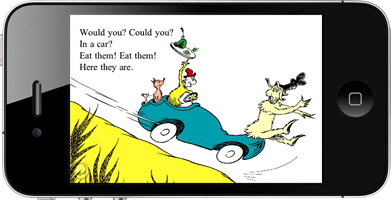
How many times have you read the story Green Eggs and Ham by Dr. Seuss? President Obama has even read this book. Check out the YouTube clip. Explore Dr. Seuss apps at Oceanhouse Media. Go to Green Eggs and Ham Video Clips and explore the many ways to enjoy these books. Then explore other examples at the Dr. Seuss Lensography.
Free Book Providers
Ebook Providers
For more e-reading environments, go to Electronic Books from Teacher Tap.
Why are apps so cool?
- Small chunks
- You don't get lost
- No heavy advertising
- Focused presentation
- Multimedia
- Connects to Social Technology
3) The Knowledge and Skills
Technology is changing the way we read and learn. Even the definition of what we mean by the word "text" is changing. (Kress, 2003). Young people need to be aware of these changes and how they impact information organization, selection, evaluation, and creation.
Age Appropriateness. Many interactive stories are based on well-known print materials are designed with specific developmental levels in mind. Shamir and Korat (2006) stress the importance of evaluating the story's structure, lexicon, syntax, and grammatical complexity based on the age of the child.
The ability to read linear texts will continue to be the foundation for reading instruction. However new media requires students also begin to develop new skills.
Reading Comprehension. Reading comprehension is a process where readers construct meaning from text. Prior knowledge and experiences are activated as the words and visuals are read and new information is assimilated. Researchers have been exploring the impact of interactive reading experiences for decades. Much of these research has been conducted with elementary aged children. When comparing conventional books with interactive books, Medwell (1998) found children reading interactive storybooks were better able to retell the story and did better on comprehension questions. Lewin (2000) found that interactive storybooks improved sight recognition of words in beginning readers. In studying electronic texts, Larson (2008) found that e-texts foster reading comprehension.
Matthew (1996) found that students who read interactive storybooks rather than print books scored significantly higher on reading comprehension questions. Sounds effects, interactive features, and animation may contribute to comprehension.
Doty, Popplewell, and Byers (2001) found no significant difference on oral retellings associated with interactive storybooks versus traditional printed books. However when comprehension was measured through questions, students reading the interactive storybook scored higher. The interactive books provided students with the ability to obtain pronunciation and definitions. Student could also click on illustrations for labels and pronunciation of words. However the audio narration feature was turned off.
While some interactive stories are organized in a linear many, others provide an initial choice of non-linear access. As such, some children don't experience the main storyline. This could explain why a number of studies have found that students have difficulty recalling the storyline however they are able to answer questions about the story.
According to Maya Eagleton (2002), "hypermedia literacy requires the ability to orchestrate and transmediate among traditional literacies and “new” literacies of visual representation, computers, and hypertext."
Increasingly, interactive book publishers are conducting their own research to support e-book use. For instance, Interactive Educational Systems Design, Inc. (2010) reported that presentation of text visually and auditorily contributes to reading comprehension particularly among struggling readers. Bi-modal presentation of text was found to support age-appropriate content knowledge. In addition, narration matched to listener's reading rate also contributed to learning.
Greenlee-Moore and Smith (1996) found significantly higher comprehension scores when students read longer and more difficult narratives on using interactive software versus paper. The interactive software provided support such as definitions.
Integral and Incidental Elements. Students must learn to identify integral and incidental elements of an interactive story. Just as they learn what are the most important components in the narrative, they also need to be able focus on the key audio, visual, animation, and other elements that are connected to the text. This begins with interactive storybooks, but continues with complex transmedia adventures.
Use Scholastics's Apps to help students make these distinctions.
Information Evaluation. Students must be able to identify the most important information and collect evidence to support their learning need. Go to Teacher Tap to find fake website that can be used to serve as discussion. Talk about fact, fiction, and fake.
4) The Attitude
Young people enjoy electronic reading. Watch iPad Guided Tour: Marvel Comics from YouTube. Consider ways to motivate readers through electronic materials focused on the interests of young people.
Motivation. Glasgow (1996) noted that reading motivation increases as a result of using interactive texts. Most students enjoy the e-Book experience. Larson (2009) found that all the students in her e-book study preferred reading e-books over traditional books. They particularly liked the tools for highlighting and note taking.
Focus. It's important to help young people stay focused in nonlinear environments. Dobon and Miall (1998) found that hypertexts can slow reading speed and cause readers to fear they've lost track of information. Readers need a framework for dealing with nonlinear and fragmented information sources. Schneider (2005) argues that today's readers are already exposed to fragmented presentations through story-bits in the form of commercials and music videos. Readers simply need to learn how to recognize the structures that exist in the particular type of text. In other words, a short story has a particular structure that readers can distinguish from an expository text. The ability to identify different types of texts and how to deal with them will be increasingly important. The same is true of helping readers identify fact and opinion.
5) The Approaches
Rather than abandoning best practices, look for ways to transform traditional approaches. Larson (2010, p.16) stresses that teachers must "address the discrepancy between the types of literacy experiences students encounter at school and those they practice in their daily lives outside the school environment". For instance, Larson (2008, p.122) suggests transforming the traditional reading workshop approach into an electronic reading workshops. Larson used Hancock's (2007) four categories to illustrate this shift:
- Literature section would involve e-books and online materials rather than print texts.
- Literature response journals would involve electronic journals and blogs rather than spiral notebooks.
- Literature conversations could be held in threaded discussions online rather than face-to-face groups.
- Project response options could incorporate technology tools for publishing and multimedia products.
It's not time to get rid of the teacher. Not all children have the metacognitive skills needed to work independently. McKenna (1998) noted that students can easily miss key story elements or misunderstand words when working independently. Medwell (1996) found that interaction with a teacher along with an interactive book had positive effect on pupils' word recognition. Trushell, Burrell, and Maitland (2001, p. 400) concluded that minimal teacher intervention is important to "ensure moderation in choice of "eye-candy" and linear progression."
Super Why is only one of many PBS Kids learning apps available for the iPad, iPhone, and iPod Touch.
Many learning opportunities are available on mobile devices such as iPhone, iTouch, and iPad. A growing number of educational producers are developing applications across the curriculum. These are particularly popular with home-school parents. For instance, iHomeEducator is a company that specializes in educational applications for the iPad. They produce a series of apps called iLive focusing on topics such as science, math, and language arts. The website contains lots of demonstration videos to give you a feel for the apps. Be sure to check out iLiveGrammar.
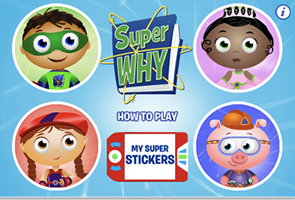
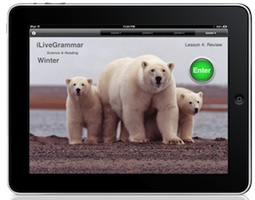
 Pearman and Chang (2010) note that for beginning readers supervision is needed help children ensure attainment of specific skills. They found that "the features provided by CD-ROM storybooks offer valuable support for the acquisition of reading skills when coupled with supervision to monitor overuse and direct instruction in comprehension strategies."
Pearman and Chang (2010) note that for beginning readers supervision is needed help children ensure attainment of specific skills. They found that "the features provided by CD-ROM storybooks offer valuable support for the acquisition of reading skills when coupled with supervision to monitor overuse and direct instruction in comprehension strategies."
In addition to the traditional role of the teacher as facilitator, instructor, model and more, Larson and Marsh (2005, p 73) notes that in the "complex, multimodal, electronic worlds" teachers must also be resource manager, co-constructor of knowledge, and design consultant providing advice on texts that meet learning needs. Lucianne Brown (2009) found that using mobile phones for vocabulary activities improved comprehension and increased motivation to learn over traditional non-digitized delivery.
Apps are becoming a part of everyday life. If you need immediate medical information, try WebMD Mobile.
Is this new world of reading really going to impact teaching and learning? Yes! It already has. Read the 2010 Kids & Family Reading Report from Scholastic to explore the changes that are already happening.
According to 2010 Kids & Family Reading Report by Scholastic (PDF) the children enjoy digital reading.
- One in four children have read an eBook.
- Over half of children ages 9-17 say they are interested in reading eBooks.
- One third of children say they would read more books for fun if they had access to eBooks on an electronic device.
- Nearly eight in ten children read for fun at least weekly, but one in five reads for fun less than once per week.
If you give a child an iPhone, iPad, Kindle, Android... you may never see it again. These tools are already part of the lives of many young people.
Traditional books won't go away, they'll just become part of a new mix of reading resources.
 Try It!
Try It!
What do you see as the key issues in digital reading environments in school libraries?
References
Bearne, E. (2005). Multimodal texts: What they are and how children use them. In J. Evans (Ed.), Literacy moves on: Popular culture, new technologies, and critical literacy in the elemen tary classroom (pp. 13-29). Portsmouth, NH: Heinemann.
Bergman, O. (1999, October). Wait for me! Reader control of narration rate in talking books. Reading Online. Available: http://www.readingonline.org/articles/bergman/
Brown, Lucianne (Fall 2009). Using mobile learning to teacher reading to ninth-grade students. Journal of Computing Teachers, 1-16.
Dobson, Teresa M. and Miall, David S. (1998). Orienting the Reader? A Study of Literary Hypertexts. SPIEL, 17, 249-262.
Doty, Deborah E., Popplewell, Scott R. & Byers, Gregg O. (Summer 2001). Interactive CD-ROM Storybooks and Young Readers' Reading Comprehension. Journal of Research on Computing in Education. Volume 33(4), 374-384.
Eagleton, M.B., & Dobler, E. (2007). Reading the web: Strategies for Internet inquiry. New York: Guilford.
Eagleton, M.B. (2002, July/August). Making text come to life on the computer: Toward an understanding of hypermedia literacy. Reading Online, 6(1). Available: http://www.readingonline.org/articles/art_index.asp?HREF=eagleton2/index.html
Glasgow, J.N. (1996). It's my turn! Part II: Motivating young read ers using CD-ROM storybooks. Learning and Leading with Technology, 24(4), 18-22.
Goldsborough, R. (2009). The latest in books and the Internet. Tech Directions, 65(10), 11.
Greenlee-Moore, M. E., & Smith, L. L. (1996). Interactive computer software: The effects on young children's reading achievement. Reading Psychology: An International Quarterly, 17(1), 43–64.
Hancock, M.R. (2007). Language arts: Extending the possibilities. Upper Saddle River, NJ: Prentice Hall.
Hassett, Dawnene & Curwood, Jen Scott (2009). Theories and Practices of Multimodal Education: The Instructional Dynamics of Picture Books and Primary Classrooms. The Reading Teacher, 63(4), 270-282.
Higgins, N., & Hess, L. (1998). Using electronic books to promote vocabulary development. ERIC Document Reproduction Service No. ED418687.
Interactive Educational Systems Design, Inc. (April 2010). What the Research Says: How Learner Interactive Books Support Reading Comprehension and Content Knowledge Acquisition. Lerner Publishing Group.
Kress, G.R. (2003). Literacy in the new media age. London, UK:Routledge.
Labbo, L. & Kuhn, M. (2000). Weaving chains of affect and cognition: a young child's understanding of CD-ROM talking books. Journal of Literacy Research, 32(2), 187–210.
Lamont C. (1997). Annotating a text: literary theory and electronic hypertext. In Sutherland K (ed)
Electronic Text Clarendon Press, Oxford, 47–66.
Larson, J., & Marsh, J. (2005). Making literacy real: Theories and practices for learning and teaching. Thousand Oaks, CA: Sage.
Larson, L otta C. (October 2008). Electronic reading workshop: Beyond books with new literacies and instructional technologies. Journal of Adolescent & Adult Literacy, 52(2), 121–131.
Larson, Lotta C. (November 2009). Digital literacies. Journal of Adolescent & Adult Literacy, 53(3), 255-258.
Larson, Lotta C. (September 2010). Digital readers: The next chapter in e-book reading and response. Reading Teacher, 64(1), 15-22.
Lefever-Davis, S., & Pearman, C. (2005). Early readers and electronic texts: Factors that influence reading behaviors. The Reading Teacher, 58(5), 446-454.
Lewin, C. (2000). Exploring the effects of talking book software in UK primary classrooms. Journal of Research in Reading, 23(2), 149–157.
Lewis, Rena B. & Ashton, Tamarah M. (1999). Interactive books on CD-ROM and reading instruction for students with learning disabilities: what are your views? 1999 Technology and Persons with Disabilities Conference Proceedings, California State University Northridge.
Matthew, K. I. (1996). The impact of CD-ROM storybooks on children's reading comprehension and reading attitude. Journal of Educational Multimedia and Hypermedia, 5(3/4), 379–394.
Matthew, K. I. (1997). A comparison of the influence of interactive CDROM storybooks and traditional print storybooks on reading comprehension. Journal of Research on Computing in Education, 29(3), 263–275.
McKenna, M. C., Cowart, E., & Watkins, J. (1997, December). Effects of talking books on the growth of struggling readers in second grade. Paper presented at the meeting of the National Reading Conference, Scottsdale, AZ.
McKenna, M. C. (1998). Electronic texts and the transformation of beginning reading. In D. Reinking, M. C. McKenna, L. D. Labbo, & R. D. Kieffer (Eds.) Handbook of literacy and technology: Transformations in a posttypographic world. (pp. 45-59). Mahwah, NJ: Lawrence Erlbaum Associates, Inc.
McNabb, M. L. (1997, December). Using electronic books to enhance reading comprehension of struggling readers. Paper presented at the meeting of the National Reading Conference, Scottsdale, AZ.
Medwell J. (1996). Talking books and reading. Reading 30(1,) 41–6.
Medwell J. (1998). The Talking Books Project: some further insights into the use of talking books
to develop reading. Reading 32(1), 3–8.
Pearman, C. (2008). Independent reading of CD-ROM storybooks: Measuring comprehension with oral retellings. The Reading Teacher, 61(8), 594-602.
Pearman, Cathy J. and Chang, Ching-Wen (July/August 2010). Scaffolding or Distracting: CD-ROM Storybooks and Young Readers. Tech Trends, 54(4), 52-57.
Reinking, D. (1997). Me and my hypertext: A multiple digression analysis of technology and literacy. The Reading Teacher, 50(8), 626-637.
Reinking, D., & Schreiner, R. (1985). The effects of computer-mediated text on measures of reading comprehension and reading behavior. Reading Research Quarterly, 20(5), 536-552.
Schneider, Ralf (August 2005). Hypertext narrative and the reader: a view from cognitive theory. European Journal of English Studies, 9(2), 197-208.
Shamir, Adina., & Korat, Ofra (2006). How to select CD-ROM storybooks for young children: The teacher's role. The Reading Teacher, 59(6), 532-543.
Trushell, John, Burrell, Clare, & Maitland, Amanda (Septemer 1, 2001). Year 5 pupils reading an "Interactive Storybook" on CD-ROM. British Journal of Educational Technology, 32(4), 389-401.
Trushell, John & Maitland, Amanda (December 2, 2004). Primary pupils' recall of interactive storybooks on CD-ROM: inconsiderate interactive features and forgetting. British Journal of Educational Technology, 36(1), 57-66.
Underwood, J. D. M. (2000). A comparison of two types of computer support for reading development.
Journal of Research in Reading, 23(2), 136–148.

